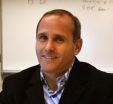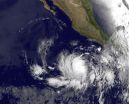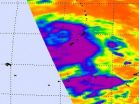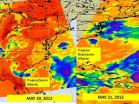(Press-News.org) CAMBRIDGE, Mass. (May 22, 2012) – Pushed to the brink of survival, the hyper-driven cells of a cancerous tumor tap into an ancient system that has helped organisms cope with internal stresses and environmental challenges since life began. As an integral part of this system, heat shock protein 90 (HSP90) has been shown to help malignant cells accommodate the genetic changes and profound disturbances in normal biology that occur in cancers.
Researchers have theorized that inhibiting HSP90 just might render breast cancer cells less likely to escape the challenge posed by cutting off their ability to use estrogen. Such is the rationale for a new clinical trial that has begun enrolling patients this week.
In the trial, patients with recurrent or metastatic estrogen receptor-positive (ER+) breast cancer will be treated either with fulvestrant, a drug currently marketed by AstraZeneca as Faslodex, or with a combination of fulvestrant and ganetespib, a drug which inhibits HSP90 and is now in clinical development by Synta Pharmaceuticals.
The trial's principal investigator is Nancy Lin, the Clinical Director of the Breast Oncology Center at Dana-Farber Cancer Institute and Assistant Professor at Harvard Medical School. Lin is collaborating with Luke Whitesell, an oncologist and senior research scientist in the lab of Whitehead Institute Member Susan Lindquist.
Breast cancer is the most common cause of cancer-related deaths in women worldwide. An estimated 40,000 women in the United States are expected to die from the disease this year. In the developed world, approximately two-thirds of all breast cancer cases are ER+. Highly dependent on their estrogen receptors for growth and survival, these tumor cells are sensitive to hormonal therapies, making drugs like tamoxifen and fulvestrant effective first-line therapies for many patients.
However, in patients with breast cancers that recur or metastasize after initial hormonal therapy, long-term remission is uncommon and life expectancy is about three years. Currently, these patients have few therapeutic options. By adding an HSP90 inhibitor, Lin and Whitesell hope to hobble the resistant cancer cells, making them less likely to escape the effects of fulvestrant.
Lin likens a malignant tumor to a car on a highway in a high-speed chase. As the car hurtles down the road, police may erect a roadblock to stop it. In the case of ER+ breast cancer, that roadblock is hormonal therapy. Unfortunately, a tumor may mutate enough to find a detour around the roadblock and continue on its destructive course. Adding a heat shock protein inhibitor to the mix may thwart the cancer's ability to find an alternate route.
"Because of the way HSP90 inhibitors work, it's like throwing a bunch of roadblocks across a bunch of detours," says Lin, who will be running the clinical part of the trial. "So the idea is to try to block these alternative pathways that might allow the tumor to grow."
"Inhibiting HSP90 in tumors may not cause them to roll over and die," says Whitesell, who with support from Susan G. Komen for the Cure will be analyzing blood and tissue samples from trial participants. "But it may change the biology of the cancer to make it more susceptible to other things that we already know work against the cancer, like fulvestrant."
The trial's premise is based on years of work the Lindquist lab has conducted on heat shock proteins. That experience is invaluable, according to Sandro Santagata, a pathologist in the Lindquist lab who will also be examining patient tissue samples.
"The Lindquist lab has a great basic scientific understanding of the biology of the heat shock system," says Santagata. "That foundation will hopefully provide important insights to increase the likelihood of success for this trial and if it doesn't work, an understanding of why. That's always a tricky part. Figuring out the 'why' is always complicated so it helps to have people like Susan and Luke who have a lot of background in the system you're studying."
For her part, Lindquist says she is looking forward to testing the therapeutic potential of targeting HSP90.
"I am very excited about the translational applications of some of the basic science we have been working on over the years," says Lindquist, who is also a professor of biology at MIT and a Howard Hughes Medical Institute (HHMI) Investigator. "Luke and I are thrilled to be working with Nancy Lin."
###
For more information on this trial, please call 617-632-3478.
This work is supported by Susan G. Komen for the Cure and Synta Pharmaceuticals.
Susan Lindquist's primary affiliation is with Whitehead Institute for Biomedical Research, where her laboratory is located and all her research is conducted. She is also a Howard Hughes Medical Institute investigator and a professor of biology at Massachusetts Institute of Technology.
Breast cancer clinical trial tests combo of heat shock protein inhibitor and hormonal therapy
2012-05-23
ELSE PRESS RELEASES FROM THIS DATE:
New study shows how nanotechnology can help detect disease earlier
2012-05-23
LEXINGTON, KY. (May 21, 2012) — A new study led by University of Kentucky researchers shows a new way to precisely detect a single chemical at extremely low concentrations and high contamination.
The study, published online for ACS Nano, was carried out in the laboratory of Peixuan Guo, the William S. Farish Endowed Chair in Nanobiotechnology at the University of Kentucky Markey Cancer Center. The study shows that the phi29 DNA packaging nanomotor connector can be used to sense chemicals with reactive thioesters or maleimide using single channel conduction assays based ...
The older we get, the less we know (cosmologically)
2012-05-23
The universe is a marvelously complex place, filled with galaxies and larger-scale structures that have evolved over its 13.7-billion-year history. Those began as small perturbations of matter that grew over time, like ripples in a pond, as the universe expanded. By observing the large-scale cosmic wrinkles now, we can learn about the initial conditions of the universe. But is now really the best time to look, or would we get better information billions of years into the future - or the past?
New calculations by Harvard theorist Avi Loeb show that the ideal time to study ...
Psychological Science explains uproar over prostate-cancer screenings
2012-05-23
WASHINGTON— The uproar that began last year when the U.S. Preventive Services Task Force stated that doctors should no longer offer regular prostate-cancer tests to healthy men continued this week when the task force released their final report. Overall, they stuck to their guns, stating that a blood test commonly used to screen for prostate cancer, the PSA test, causes more harm than good — it leads men to receive unnecessary, and sometimes even dangerous, treatments.
But many people simply don't believe that the test is ineffective. Even faced with overwhelming evidence, ...
Array of light for early disease detection?
2012-05-23
A special feature in this week's issue of the journal Science highlights protein array technology, touching on research conducted by Joshua LaBaer, director of the Biodesign Institute's Virginia G. Piper Center for Personalized Diagnostics.
With the successful completion of the Human Genome Project, research attention is increasingly focusing on proteins. Versatile products produced from genetic templates, proteins are principle actors in both the maintenance of health and the onset of illness. Protein microarrays are a means of bridging the gap between analysis of the ...
NASA Sees Eastern Pacific's Second Tropical Storm Form
2012-05-23
On May 21, NASA satellites were monitoring Tropical Depression 02E in the eastern Pacific Ocean, and 24 hours later it strengthened into the second tropical storm of the season. Tropical Storm Bud was captured by NOAA's GOES-13 satellite on May 22, and appears to be well-formed.
Tropical Storm Bud isn't going to stop there, however. According to the forecasters at the National Hurricane Center, Bud is expected to become a hurricane because of light to moderate wind shear and warm sea surface temperatures.
On May 22 at 0900 UTC (2 a.m. PDT/5 a.m. EDT), Tropical Storm ...
NASA satellite sees Tropical Storm Sanvu pass Guam, strengthen
2012-05-23
Tropical Depression 03W in the western North Pacific did exactly what forecasters expected over the last twenty-four hours: it became a tropical storm named Sanvu and passed west of Guam on a northwesterly track.
On May 22 at 0900 UTC (5 a.m. EDT), Tropical Storm Sanvu was more than 100 miles west-northwest of Andersen Air Force Base, Guam, and still over 600 nautical miles south of Iwo To, Japan and headed in that direction. Sanvu's center was located near 15.2 North and 141.9. East. It was still churning up rough surf around Guam. Sanvu has maximum sustained winds near ...
Barrow researchers use magic for discoveries
2012-05-23
(Phoenix, AZ May 22, 2012) -- Researchers at Barrow Neurological Institute at St. Joseph's Hospital and Medical Center have unveiled how and why the public perceives some magic tricks in recent studies that could have real-world implications in military tactics, marketing and sports.
Susana Martinez-Conde, PhD, of Barrow's Laboratory of Visual Neuroscience, and Stephen Macknik, PhD, of Barrow's Laboratory of Behavioral Neurophysiology are well known for their research into magic and illusions. Their most recent original research projects, published in Frontiers in Human ...
Alberto now a tropical depression, seen by NASA
2012-05-23
Infrared satellite imagery from NASA's Aqua satellite revealed Alberto weakened from a tropical storm to a tropical depression as it appears more disorganized. At 10:30 a.m. EDT on May 21, Tropical Storm Alberto weakened to a tropical depression, and has maintained that status today, May 22.
As of 5 a.m. EDT on May 22, Alberto's maximum sustained winds were near 35 mph (55 kph) but he is expected to weaken in 24 hours. Alberto was centered about 220 miles south of Cape Hatteras, North Carolina, near 32.0 North and 75.5 West. Alberto was moving to the northeast near 15 ...
Cleft lip/palate cause much more than cosmetic problems
2012-05-23
MAYWOOD, Ill. -- Children born with cleft lip, cleft palate and other craniofacial disorders face numerous medical challenges beyond appearance.
Patients can face serious airway, feeding, speech and hearing problems, as well as social and psychological challenges, Laura Swibel Rosenthal, MD, of Loyola University Medical Center and colleagues write in the June 2012 issue of Otolaryngologic Clinics of North America.
"The management of patients with craniofacial syndromes is complex," Rosenthal and colleagues write. "Otolaryngologic [ear-nose-throat] evaluation is of paramount ...
Scientists start explaining Fat Bastard's vicious cycle
2012-05-23
This press release is available in French.
VIDEO:
Stephanie Fulton of Université de Montréal and its affiliated research hospital studies the behavior of mice and their brain chemistry to reveal how humans may act in similar circumstances.
Click here for more information.
Fat Bastard's revelation "I eat because I'm depressed and I'm depressed because I eat" in the Austin Powers ...



